A
wind turbine is a rotating machine which converts the kinetic
energy in wind into mechanical
energy. If the mechanical energy is used directly by machinery,
such as a pump or grinding stones, the machine is usually called
a windmill. If the mechanical energy is then converted to electricity,
the machine is called a wind generator, wind turbine,
wind power unit (WPU), wind energy converter (WEC),
or aerogenerator.
This article
discusses electric power generation machinery. Windmill discusses
machines used for grain-grinding, water pumping, etc. The article
on wind power describes turbine placement, economics and public
concerns. The wind energy section of that article describes the
distribution of wind energy over time, and how that affects wind-turbine
design. See environmental concerns with electricity generation
for discussion of environmental problems with wind-energy production.
History
-
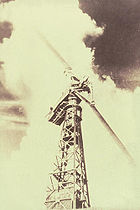
The world's
first megawatt wind turbine at Castleton, Vermont
Wind machines
were used in Persia as early as 200 B.C. This type of machine
was introduced into the Roman Empire by 250 A.D. However, the
first practical windmills were built in Sistan, Iran, from the
7th century. These were vertical axle windmills, which had long
vertical driveshafts with rectangle shaped blades.[1] Made of six
to twelve sails covered in reed matting or cloth material, these
windmills were used to grind corn and draw up water, and were
used in the gristmilling and sugarcane industries.[2]
By the 14th
century, Dutch windmills were in use to drain areas of the Rhine
River delta. In Denmark by 1900 there were about 2500 windmills
for mechanical loads such as pumps and mills, producing an estimated
combined peak power of about 30 MW. The first known electricity
generating windmill operated was a battery charging machine installed
in 1887 by James Blyth in Scotland, UK. The first windmill for
electricity production in the United States was built in Cleveland,
Ohio by Charles F Brush in 1888, and in 1908 there were 72 wind-driven
electric generators from 5 kW to 25 kW. The largest machines were
on 24 m (79 ft) towers with four-bladed 23 m (75 ft) diameter
rotors. Around the time of World War I, American windmill makers
were producing 100,000 farm windmills each year, most for water-pumping.[3] By
the 1930s windmills for electricity were common on farms, mostly
in the United States where distribution systems had not yet been
installed. In this period, high-tensile steel was cheap, and windmills
were placed atop prefabricated open steel lattice towers.
A forerunner
of modern horizontal-axis wind generators was in service at Yalta,
USSR in 1931. This was a 100 kW generator on a 30 m (100 ft) tower,
connected to the local 6.3 kV distribution system. It was reported
to have an annual capacity factor of 32 per cent, not much different
from current wind machines.[4]
The first
utility grid-connected wind turbine operated in the UK was built
by the John Brown Company in 1954 in the Orkney Islands. It had
an 18 meter diameter, three-bladed rotor and a rated output of
100 kW.
Potential
turbine power
-
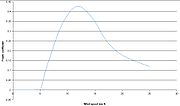
Wind Turbine
Power Coefficient
The amount
of power transferred to a
wind turbine is directly proportional to the area swept out by
the rotor, to the density of the air, and the cube of the wind
speed.
The power
P in the wind is given by:
 ,
,
where P =
power in watts., ╬▒ = an efficiency factor determined by
the design of the turbine, Žü = mass density of air in
kilograms per cubic meter, r = radius of the wind turbine
in meters, and v = velocity of the air in meters per second.[5]
As the wind
turbine extracts energy from the air flow, the air is slowed down
which causes it to spread out. Albert Betz, a German physicist,
determined in 1919 (see Betz' law) that a wind turbine can extract
at most 59% of the energy that would otherwise flow through the
turbine's cross section, that is ╬▒ can never be higher
than 0.59 in the above equation. The Betz limit applies regardless
of the design of the turbine.
This equation
shows the effects of the mass rate of flow of air traveling through
the turbine, and the energy of each unit mass of air flow caused
by its velocity. As an example, on a cool 15 ┬░C (59 ┬░F)
day at sea level, air density is 1.225 kilograms per cubic
metre. An 8 m/s (28.8 km/h or 18 mi/h) breeze blowing
through a 100 meter diameter rotor would move almost 77,000 kilograms
of air per second through the swept area. The total power of the
example breeze through a 100 meter diameter rotor would be
about 2.5 megawatts. Betz' law states that no more than 1.5
megawatts could be extracted.
Types
of wind turbines
Wind turbines
can be separated into two types based by the axis in which the
turbine rotates. Turbines that rotate around a horizontal axis
are more common. Vertical-axis turbines are less frequently used.
Horizontal
axis
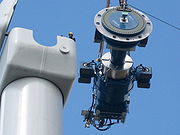
Components
of a horizontal axis wind turbine (gearbox, rotor shaft and
brake assembly) being lifted into position
Horizontal-axis
wind turbines (HAWT) have the main rotor shaft and electrical
generator at the top of a tower, and must be pointed into the
wind. Small turbines are pointed by a simple wind vane, while
large turbines generally use a wind sensor coupled with a servo
motor. Most have a gearbox, which turns the slow rotation of the
blades into a quicker rotation that is more suitable to drive
an electrical generator.[6]
Since a tower
produces turbulence behind it, the turbine is usually pointed
upwind of the tower. Turbine blades are made stiff to prevent
the blades from being pushed into the tower by high winds. Additionally,
the blades are placed a considerable distance in front of the
tower and are sometimes tilted up a small amount.
Downwind machines
have been built, despite the problem of turbulence, because they
don't need an additional mechanism for keeping them in line with
the wind, and because in high winds, the blades can be allowed
to bend which reduces their swept area and thus their wind resistance.
Since turbulence leads to fatigue failures, and reliability is
so important, most HAWTs are upwind machines.
HAWT
Subtypes
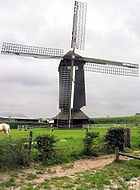
Doesburger
windmill, Ede, The Netherlands.
There are
several types of HAWT:
- 12th-century
windmills
These squat
structures, typically (at least) four bladed, usually with wooden
shutters or fabric sails, were developed in Europe. These windmills
were pointed into the wind manually or via a tail-fan and were
typically used to grind grain. In the Netherlands they were also
used to pump water from low-lying land, and were instrumental
in keeping its polders dry.
In Schiedam,
the Netherlands, a traditional style windmill (the Noletmolen)
was built in 2005 to generate electricity.[7]
The mill is one of the tallest Tower mills in the world, being
some 42.5 metres (139 ft) tall.
- 19th-century
windmills
The Eclipse
windmill factory was set up around 1866 in Beloit, Wisconsin and
soon became successful building mills for pumping water on farms
and for filling railroad tanks. Other firms like Star, Dempster,
and Aeromotor also entered the market. Hundreds of thousands of
these mills were produced before rural electrification and small
numbers continue to be made.[3] They
typically had many blades, operated at tip speed ratios
(defined below) not better than one, and had good starting torque.
Some had small direct-current generators used to charge storage
batteries, to provide power to lights, or to operate a radio receiver.
The American rural electrification connected many farms to centrally-generated
power and replaced individual windmills as a primary source of
farm power by the 1950s. They were also produced in other countries
like South Africa and Australia (where an American design was
copied in 1876[8]). Such devices are still used
in locations where it is too costly to bring in commercial power.
- Modern
wind turbines
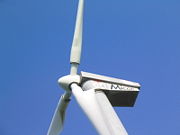
Three bladed
wind turbine
Turbines used
in wind
farms for commercial production of electric power are usually
three-bladed and pointed into the wind by computer-controlled
motors. These have high tip speeds of up to six times the wind
speed, high efficiency, and low torque ripple, which contribute
to good reliability. The blades are usually colored light gray
to blend in with the clouds and range in length from 20 to 40
metres (65 to 130 ft) or more. The tubular steel towers range
from 200 to 300 feet (60 to 90 metres) tall. The blades rotate
at 10-22 revolutions per minute.[9][10] A gear box
is commonly used to step up the speed of the generator, although
designs may also use direct drive of an annular generator. Some
models operate at constant speed, but more energy can be collected
by variable-speed turbines which use a solid-state power converter
to interface to the transmission system. All turbines are equipped
with shut-down features to avoid damage at high wind speeds.
HAWT
advantages
- Variable
blade pitch, which gives the turbine blades the optimum angle
of attack. Allowing the angle of attack to be remotely adjusted
gives greater control, so the turbine collects the maximum amount
of wind energy for the time of day and season.
- The tall
tower base allows access to stronger wind in sites with wind
shear. In some wind shear sites, every ten meters up, the wind
speed can increase by 20% and the power output by 34%.
HAWT
disadvantages
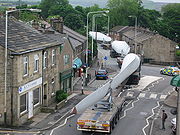
Turbine
blade convoy passing through Edenfield in the UK
- HAWTs have
difficulty operating in near ground, turbulent winds.
- The tall
towers and blades up to 90 meters long are difficult to transport.
Transportation can now cost 20% of equipment costs.
- Tall HAWTs
are difficult to install, needing very tall and expensive cranes
and skilled operators.
- Massive
tower construction is required to support the heavy blades,
gearbox, and generator.
- Reflection
on tall HAWTs may affect side lobs of radar installations creating
signal clutter, although filtering can suppress it.
- Their height
makes them obtrusively visible across large areas, disrupting
the appearance of the landscape and sometimes creating local
opposition.
- Downwind
variants suffer from fatigue and structural failure caused by
turbulence.
- HAWTs require
an additional yaw control mechanism to turn the blades toward
the wind.
Vertical
axis
Vertical-axis
wind turbines (or VAWTs) have the main rotor shaft arranged
vertically. Key advantages of this arrangement are that the turbine
does not need to be pointed into the wind to be effective. This
is an advantage on sites where the wind direction is highly variable.
VAWTs can utilize winds from varying directions.
With a vertical
axis, the generator and gearbox can be placed near the ground,
so the tower doesn't need to support it, and it is more accessible
for maintenance. Drawbacks are that some designs produce pulsating
torque. Drag may be created when the blade rotates into the wind.
It is difficult
to mount vertical-axis turbines on towers, meaning they are often
installed nearer to the base on which they rest, such as the ground
or a building rooftop. The wind speed is slower at a lower altitude,
so less wind energy is available for a given size turbine. Air
flow near the ground and other objects can create turbulent flow,
which can introduce issues of vibration, including noise and bearing
wear which may increase the maintenance or shorten the service
life. However, when a turbine is mounted on a rooftop, the building
generally redirects wind over the roof and this can double the
wind speed at the turbine. If the height of the rooftop mounted
turbine tower is approximately 50% of the building height, this
is near the optimum for maximum wind energy and minimum wind turbulence.
- No massive
tower structure is needed.
- As the
rotor blades are vertical, no yaw mechanism is needed.
- A VAWT
can be located nearer the ground, making it easier to maintain
the moving parts.
- VAWTs have
a higher airfoil pitch angle, giving improved aerodynamics while
decreasing drag at low and high pressures.
- Straight
bladed VAWT designs with a square or rectangular cross-section
have a larger swept area for a given diameter than the circular
swept area of HAWTs.
- VAWTs have
lower wind startup speeds than HAWTs. Typically, they start
creating electricity at 6 m.p.h. (10 km/h).
- VAWTs usually
have a lower tip speed ratio and so are less likely to break
in high winds.
- VAWTs may
be built at locations where taller structures are prohibited.
- VAWTs situated
close to the ground can take advantage of locations where mesas,
hilltops, ridgelines, and passes funnel the wind and increase
wind velocity.
- VAWTs do
not need to turn to face the wind if the wind direction changes.
- VAWT blades
are easily seen and avoided by birds.
- Most VAWTs
start easily and do not require energy to begin turning.
VAWT
disadvantages
- Most VAWTs
produce energy at only 50% of the efficiency of HAWTs in large
part because of the additional drag that they have as their
blades rotate into the wind. Versions that reduce drag produce
more energy, especially those that funnel wind into the collector
area.
- VAWTs will
rotate faster in stronger winds at higher elevations as they
rotate at least as fast as the wind velocity.
- A VAWT
that uses guy-wires to hold it in place puts stress on the bottom
bearing as all the weight of the rotor is on the bearing. Guy
wires attached to the top bearing increase downward thrust in
wind gusts. Solving this problem requires a superstructure to
hold a top bearing in place to eliminate the downward thrusts
of gust events in guy wired models.
- While VAWTs'
parts are located on the ground, they are also located under
the weight of the structure above it, which can make changing
out parts nearly impossible without dismantling the structure
if not designed properly.
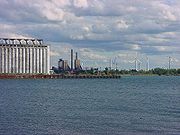
Wind turbines
on the Lake Erie shore at Lackawanna, New York
Small
wind turbines
-
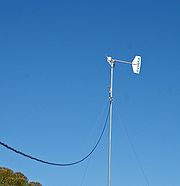
A small
wind turbine being used at the Riverina Environmental Education
Centre near Wagga Wagga, New South Wales, Australia
Small wind
turbines may be as small as a fifty-watt generator for boat or
caravan use. Small units often have direct drive generators, direct
current output, aeroelastic blades, lifetime bearings and
use a vane to point into the wind. Larger, more costly turbines
generally have geared power trains, alternating current output,
flaps and are actively pointed into the wind. Direct drive generators
and aeroelastic blades for large wind turbines are being researched.
Criticisms
Wind turbines
have very few impacts on the environment other than aesthetic
effects, although VAWT designs are increasingly being designed
with innovative artistic aesthetics.
Wind Turbine
Syndrome is a clinical phenomenon first coined by Nina Pierpont.
According to her research, some people, when living in close proximity
to horizontal axis industrial wind turbines, are affected by low-frequency
vibrations emanating from the turbine. VAWT do not lend themselves
to this effect as they do not rotate faster than wind speed.
- References
- Ahmad
Y Hassan, Donald Routledge Hill (1986). Islamic Technology:
An illustrated history, p. 54. Cambridge University Press.
- Donald
Routledge Hill, "Mechanical Engineering in the Medieval Near
East", Scientific American, May 1991, p. 64-69.
- Quirky old-style contraptions make water from wind on the mesas
of West Texas
-
Alan Wyatt: Electric Power: Challenges and Choices.
Book Press Ltd., Toronto 1986,
-
Iowa Energy Center Wind Energy Manual.
- http://www.windpower.org/en/tour/wtrb/comp/index.htm Wind turbine
components retrieved 2008 Nov 8
- Molendatabase Dutch text
-
Extract from Triumph of the Griffiths Family, http://au.geocities.com/ozwindmills/SouthernCross.htm, Bruce
Millett, 1984, accessed January 26, 2008
- 1.5 MW Wind Turbine Technical Specifications
- Size specifications
of common industrial wind turbines
-
"Wind Turbine Design Cost and Scaling Model," Technical Report
NREL/TP-500-40566, December, 2006, page 35,36. http://www.nrel.gov/docs/fy07osti/40566.pdf
-
Magenn Power Inc. -
Technology
-
see http://www.bwea.com/marine/devices.html and scroll down to
SPERBOYŌäó,
- Jacobs wind
turbine (page 18)
- Mawson Station Electrical Energy - Australian Antarctic Division
Further
reading
- BBC News,"Wind
farms 'must take root in UK", http://news.bbc.co.uk/2/hi/science/nature/4560139.stm, BBC
News, Copyright 2007
- Tony Burton,
David Sharpe, Nick Jenkins, Ervin Bossanyi: Wind Energy Handbook,
John Wiley & Sons, 1st edition (2001),
- Darrell,
Dodge, Early History Through 1875, TeloNet Web Development,
http://telosnet.com/wind/early.html, Copyright 1996-2001
- David,
Macaulay, New Way Things Work, Houghton Mifflin Company, Boston,
Copyright 1994-1999, pg.41-42
External
links
WindTurbine.net
-- A Social Network for the Wind Turbine Community
This the first
social networking website that has to do with the wind energy
community. Visitors to www.windturbines.net
have the opportunity to open up a free account where they
can communicate, collaborate and network with other like-minded
individuals. They are also in the process of creating the most
complete resource / wiki (www.windturbines.net/wiki)
having to do with the topic of wind turbines and wind energy.

